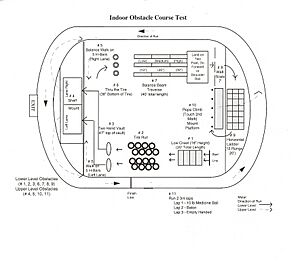Indoor Obstacle Course Test facts for kids
Quick facts for kids Indoor Obstacle Course Test |
|
|---|---|
 |
|
| Date(s) | Periodically throughout the year; primary test is in February |
| Location(s) | Hayes Gym, USMA |
| Inaugurated | 1944 |
The Indoor Obstacle Course Test (IOCT) is a challenging physical test. It checks how fit and strong students are at the United States Military Academy in West Point, New York. This academy trains future leaders for the Army. The IOCT is seen as one of the best ways to measure overall body fitness. Students who do very well on the test can earn a special badge. They get to wear this badge on their sports shorts.
Contents
What is the IOCT?
The IOCT takes place in the old Hayes Gymnasium. This gym was built a long time ago, in 1910. Imagine an obstacle course you might see on a TV show. The IOCT is a bit like that, but it ends with a fast run. Students at the academy take this test throughout the school year. Many people, including other students and officers, come to watch. It's a big event!
Why is the IOCT Important?
The IOCT is very important for future soldiers. It helps them build key skills like balance, agility, and coordination. These skills are needed for many tasks in the Army. The test has been around for a long time, since 1944. Because of its long history, experts often study the IOCT. They learn how people perform in tough physical challenges. This helps them understand human fitness better.
What Happens During the IOCT?
The IOCT has 11 different challenges. You do them one after another. First, you do a low crawl under a barrier. Then, you quickly move your feet through tires. Next is a two-handed vault over something. You also have to get over an 8-foot horizontal shelf. After that, you navigate across horizontal bars. You then swing on a hanging tire. There's also a balance beam to cross. You must climb an 8-foot vertical wall. Then, you cross a 20-foot horizontal ladder. Finally, you climb a 16-foot vertical rope. The test ends with a 350-meter sprint. For part of the sprint, you carry a medicine ball. For another part, you carry a baton. The last part is run empty-handed. This test needs a lot of skill and effort. It is a very important part of being a student at West Point.
How the IOCT Started and Changed
The IOCT began in 1944 during World War II. It was created to better measure how physically fit students were. After the war, the test was updated. The obstacles became more like what you see today.
Here are some key changes over the years:
- 1948: The test was reviewed. Some military-specific parts were replaced. New obstacles were added to test agility, strength, and balance.
- 1975: A "dive roll" at the start was removed. This was done to prevent injuries. A low crawl was put in its place.
- 1981: Important changes were made to help all students. Obstacles that needed a lot of upper body strength were changed. A tire run and balance beam were added. This made the test fairer for everyone.
- 1982: The times needed to pass the IOCT were updated.
- 2002: More students were required to take the IOCT. Their scores became part of their overall physical grade.
- 2014: Since 2014, all students must take the IOCT every year. This helps ensure everyone stays fit.
How Scores Are Used
The IOCT has different passing times for male and female students. This is because physical abilities can vary. Students can retake the test to improve their score. Only their best score from the year counts. This helps students try their hardest. Their IOCT score is part of their overall physical fitness grade.
IOCT Grade Scale
This table shows the different times needed to earn each grade on the IOCT. The times are different for men and women.
| Grade | Men's Time | Women's Time |
|---|---|---|
| A+ | 2:26 or Less | 3:14 or Less |
| A | 2:27-2:33 | 3:15-3:25 |
| A- | 2:34-2:38 | 3:26-3:35 |
| B+ | 2:39-2:41 | 3:36-3:47 |
| B | 2:42-2:44 | 3:48-4:01 |
| B- | 2:45-2:49 | 4:04-4:06 |
| C+ | 2:50-2:54 | 4:07-4:24 |
| C | 2:55-3:01 | 4:25-4:54 |
| C- | 3:02-3:13 | 4:55-5:17 |
| D | 3:14-3:30 | 5:18-5:29 |
| F | 3:31+ | 5:30+ |
Images for kids









